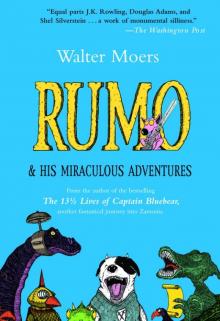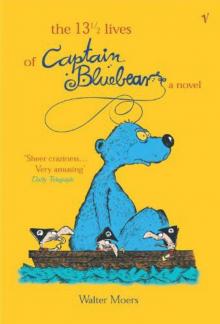- Home
- Walter Moers
The 13.5 Lives of Captain Bluebear
The 13.5 Lives of Captain Bluebear Read online
Contents
Cover
About the Book
About the Author
Map
Title Page
Epigraph
Foreword
1. My Life as a Minipirate
2. My Life with the Hobgoblins
3. My Life on the Run
4. My Life on Gourmet Island
5. My Life as a Navigator
6. My Life in the Gloomberg Mountains
7. My Life in the Great Forest
8. My Life in the Dimensional Hiatus
9. My Life in the Demerara Desert
10. My Life in Tornado City
11. My Life in the Bollogg’s Head
12. My Life in Atlantis
13. My Life aboard the SS Moloch
13½. My Half-Life at Peace
Copyright
About the Book
A delightfully illustrated cult novel, literary satire and epic adventure.
About the Author
Walter Moers was born in 1957. A celebrated illustrator, cartoonist and novelist, he lives in Hamburg.
‘Life is too precious to be left to chance.’
Deus X. Machina
Foreword
A bluebear has twenty-seven lives. I shall recount thirteen-and-a-half of them in this book but keep quiet about the rest. A bear must have his secrets, after all; they make him seem attractive and mysterious.
People often ask me what it was like in the old days. My answer: In the old days there was a lot more of everything. Yes, there used to be mysterious islands, kingdoms and whole continents that no longer exist. They lie beneath the waves of the eternal ocean, for the waters are slowly but inexorably rising higher and higher, and one day our planet will be entirely submerged. That is why I now live in a seaworthy ship perched on a cliff high above sea level. I propose to tell you about the aforesaid submerged islands and countries and the creatures and marvels that sank below the waves with them.
I should be lying (and everyone knows I’m not a liar by nature) if I claimed that my first thirteen-and-a-half lives were uneventful. What about the Minipirates? What about the Hobgoblins, the Spiderwitch, the Babbling Billows, the Troglotroll, the Mountain Maggot? What about the Alpine Imp, the headless Bollogg, the Bolloggless head, the nomadic Muggs, the Captive Mirage, the Yetis and Bluddums, the Eternal Tornado, the Rickshaw Demons? What about the Venomous Vampires, the Gelatine Prince from the 2364th Dimension, the Professor with Seven Brains, the Demerara Desert, Knio the Barbaric Hog, the Wolperting Whelps, the Cogitating Quicksand, the Noontide Ghouls, the Infurno, the Ship with a Thousand Funnels? What about Gourmet Island, Tornado City, the Sewer Dragon, the Duel of Lies, dimensional hiatuses, Voltigorkian Vibrobassists, rampaging Mountain Dwarfs? What about the Invisibles, the Norselanders, the Venetian Midgets, the Midgard Serpent, the revolting Kackertratts, the Valley of Discarded Ideas, the Witthogs, the Big-Footed Bertts, the Humongous Mountains? What about Earspoonlets, Time-Snails, Diabolic Elves, Mandragors, Olfactils, the Upper Jurassic Current, the smell of Genff? Mine is a tale of mortal danger and eternal love, of hair’s-breadth, last-minute escapes … But I mustn’t get ahead of myself!
Nostalgia overcomes me when I recall those days, but the clock of life cannot be turned back. This, although regrettable, is only fair.
Winter is following autumn in its time-honoured way. The sun, cold as the moon, is sinking into the icy grey sea below my cliff, and the wind smells of snow. But there’s something else in the air as well: the scent of bonfires burning in the distance. It carries a hint of cinnamon, a whiff of adventure! I always used to follow that scent, but today I’ve something more important to do. My memoirs must be preserved for posterity. Frost-sprites are insinuating their clammy fingers between the floorboards of my cabin and groping for my feet. Invisible ice-witches are painting frost flowers on the windows. Hardly my favourite season of the year, but the ideal time to brew a pot of hot cocoa (with a wee dash of rum in it), fill thirteen-and-a-half pipes with tobacco, make thirteen-and-a-half slices of bread and jam, sharpen thirteen-and-a-half pencils, and begin to record my first thirteen-and-a-half lives. A bold and arduous undertaking of epic dimensions, I fear. For, as I already said, there was a lot more of everything in the old days – more adventures, too, of course.
My strange birth
PEOPLE USUALLY START life by being born. Not me, though. That’s to say, I don’t know how I came into the world. Purely theoretically, I could have emerged from the foam on the crest of a wave or developed inside a seashell, like a pearl. Then again, I might have fallen from the sky like a shooting star.
The only certainty is that I was a foundling abandoned in the middle of the ocean. My earliest memory is of being afloat in rough seas, naked and alone in a walnut shell, for at first I was very, very small.
I also remember a sound – a very big sound. When you’re little you tend to overestimate the size of things, but I now know that it really was the biggest sound in the world.
The Malmstrom
Its source was the loudest, most monstrous and dangerous whirlpool anywhere in the seven seas. I had no idea, of course, that my little nutshell was bobbing towards the dreaded Malmstrom. To me it was just a gigantic gurgling sound. I probably thought (if I ‘thought’ at all at that stage) that it was the most natural thing in the world to lie naked in a nutshell and drift across the open sea towards the origin of that deafening roar.
The sound grew louder and louder and the nutshell bobbed more and more violently, but I was equally unaware, of course, that I had long been in the grip of the whirlpool. My tiny boat, probably the smallest in the world, went dancing towards the roaring abyss in a miles-long spiral.
It should be borne in mind that this was just about the most hopeless predicament in which anyone at sea could find himself. Any mariner in his senses gave the Malmstrom the widest possible berth, and even if someone had come to my rescue he would have suffered the same fate: he would have been sucked down with me to the bed of the ocean, for no vessel could withstand the pull of the whirlpool.
My nutshell now began to rotate on its own axis, dancing to perdition in waltz time as it descended into the ocean’s gurgling maw. As for me, I merely watched the stars spinning around overhead and listened entranced to the Malmstrom, quite free from any forebodings.
And that was when I first heard one of the Minipirates’ weird songs.
The Minipirates
The Minipirates were the masters of the Zamonian Sea. Nobody knew this, however, because they were too small to be noticed. No wave was too high, no storm too tempestuous and no whirlpool too powerful for them not to defy it. The most audacious of all seafarers, they were forever seeking opportunities to demonstrate their nautical skill, even when confronted by the most potent of natural forces. Thanks to their exceptional seamanlike abilities, they alone were capable of tackling the Malmstrom.
That was how they had ended up in the whirlpool, out of pure bravado, bawling their defiant pirate songs. The masthead lookout, carefully scanning the surface for the most favourable currents and wave-tunnels, had sighted me through his tiny telescope just as I was about to be engulfed by the Malmstrom.
I was doubly fortunate to have been found by the Minipirates, of all people, because anyone of normal size would probably have failed to spot me. They hauled me aboard, wrapped me up in oilskins, and lashed me to the mast with thick ropes – a safety measure that puzzled me exceedingly at the time. Meantime, they continued to wage their heroic battle with the elements as a matter of course, scampering up and down the masts like squirrels, hoisting and reefing sails at a rate that made me dizzy just to watch. As one man, they offset the motion
of the pitching, tossing vessel by hurling themselves to port or starboard, forward or aft. They manned the pumps or vanished into the bowels of the ship and reappeared with brimming buckets, leapt through hatchways, swung to and fro on the halyards. In constant motion, they wrestled with the ship’s wheel, bellowed at each other, hauled on ropes, joined forces to hoist a mainsail in double-quick time, and never for one moment forgot to sing their pirate sea shanties. I even recall that one of them persisted in scrubbing the deck throughout this pandemonium.
Deluged with spray, the ship lay over on her side, reared skywards, and was actually submerged more than once, but she didn’t sink. I swallowed some seawater for the first time, and am bound to say it didn’t taste too bad. We glided through wave-tunnels, rode mighty mountains of foam, were tossed high into the air and carried down into the depths. The ship was hurled to and fro, buffeted, jostled and spat on by gigantic billows, but the Minipirates were undaunted. They yelled at the sea, spat back at it, and defiantly jabbed the waves with their grappling hooks. They fanned out among the masts at lightning speed, reefed sails and unfurled them a moment later. They reacted to every quirk of the sea, every puff of wind and movement of the ship, and knew at once what had to be done next. No one gave any orders, all were of equal rank. Thanks to their joint endeavours, they finally overcame the mighty ocean while I myself, securely lashed to the mast, watched their activities with the utmost amazement.
If you’re as small as a Minipirate (as small as I was, too, at the time), you live in another time dimension. Anyone who has ever tried to capture a fly in his hand will know that the tiny creature is far superior in terms of speed and agility. We operate in slow motion from the fly’s point of view, so it can easily outmanoeuvre and evade us. It was the same with the Minipirates. To them, what the crew of a ship of normal size would regard as a raging whirlpool seemed a mere eddy. Every huge billow consisted of many wavelets through which they could navigate with ease. Just as a hurricane can sweep across a city and topple the tallest buildings but leave a little spider’s web intact, so the monstrous whirlpool could not harm us. We were protected by our diminutive size.
So we escaped from the deadly Malmstrom. I was unaware of its true dangers, as I have said – they didn’t dawn on me until much later. All I noticed was that the gurgling sound steadily faded and the Minipirates’ activities became less frantic. The situation eventually eased so much that they could gather round, untie my rope, and gaze at me in wonderment.
I gazed back at them.
Minipirates, as their name implies, were pretty small. A Minipirate six inches tall was considered a giant by his own kind. The little creatures sailed the seas in tiny ships, ever on the lookout for a something small enough to capture. This happened very seldom – never, in fact. Truth to tell, the Minipirates had never managed to capture a single prize, not even a rowing boat, in the whole history of navigation. Sometimes, usually in desperation, they attacked bigger ships, even ocean-going giants, but their efforts passed unnoticed as a rule. The tiny buccaneers hurled their grappling hooks at the big vessels and were towed along until they gave up. Either that, or they fired their dinky little cannon, but the cannon balls always fell short and splashed harmlessly into the sea after travelling only a few yards.
Because they never captured any booty, the Minipirates lived mainly on seaweed or such fish as they were capable of tackling – sardines, for instance, or very small scampi. They didn’t turn up their noses at plankton, either, if times were hard.
The Minipirates had little iron hooks instead of hands and wooden stumps instead of proper legs, nor did I ever see one without an eyepatch. At first I thought they’d been wounded during their reckless attempts to board a prize, but I later learned that they were born that way, complete with hats and moustaches.
From the
‘Encyclopedia of Marvels, Life Forms and Other Phenomena of Zamonia and its Environs’
by Professor Abdullah Nightingale
Minipirates. Despite their essential harmlessness, or possibly because of it, Minipirates affect an extremely gruff and bloodthirsty manner. They like to deliver grandiloquent speeches, preferably about successful voyages of depredation and fat prizes. The uncharitable might accuse them of a penchant for bragging. Whenever two Minipirates encounter each other [a frequent occurrence in a crowded ship], they simultaneously, with sweeping gestures and much shouting, list the merchant ships they claim to have sent to the bottom and boast of innocent seamen mercilessly keelhauled or made to walk the plank. While so doing they drink rhumm, a beverage compounded of seaweed juice and molasses which, although it contains no alcohol whatever, stimulates their imagination and quickly slurs their speech. Minipirates have rather weak heads.
I have often witnessed such encounters and listened to the Minipirates’ grandiose rodomontades. I must, however, admit to having been influenced by their richly embroidered tales and extravagant flights of fancy. They taught me that a good white lie is often considerably more exciting than the truth. Telling one is like dressing up reality in its Sunday best.
Pirate songs and lamentations
To a Minipirate, nothing was worse than boredom. As soon as one of them grew even the slightest bit bored he betrayed such agony of mind that it wrung your heart. He would sigh and groan and shake his hook at the sky, ruffle his hair, and sometimes even tear his clothes. This only made matters worse, because he would then bemoan the rents in his outfit and accuse fate of heaping him with misfortune. Boredom being a frequent guest aboard every ship at sea, the Minipirates were forever moaning and groaning. If they weren’t moaning they were boasting. And if they were neither moaning nor boasting they were belting out pirate songs. Such was the atmosphere in which I grew up.
I became the central feature of the Minipirates’ life. During the five years I spent with them, their activities revolved around me to the exclusion of almost everything else. It was as if I had at last lent some meaning to their ludicrous existence. They made touching efforts to teach me all they knew about buccaneering and the piratical way of life. They devoted entire days to singing me gruesome pirate songs, uttering oaths, hoisting the Jolly Roger, drawing maps that purported to show the location of buried treasure. Once they even tried, for my benefit, to capture a vessel at least a thousand times bigger than their own. That was a day that taught me the meaning of abject failure.
I learn seamanship
The seaman’s trade, from raising anchor to caulking seams and bracing the shrouds, I learned simply by watching and lending a hand.
I began by scrubbing the deck. It can be a real art to scrub a deck clean of every voracious bacterium, but not so smooth as to render it slippery underfoot (a particularly important consideration in the case of the Minipirates, with their spindly peg-legs). Soft soap with a small admixture of sand is the ideal substance for scouring decks: the soap for cleanliness and the sand for grip. I learned how to sail close-hauled and how to lie to in a lull, how to make the most of a following breeze, how to wear ship, how to go about in a heavy sea, and how to stop dead (a trick mastered only by the Minipirates, who used it to avoid dangerous collisions with sizeable fish – in their case, anything bigger than a cod).
Seaman’s knots
Knots are one of the most important aspects of a seaman’s life. I don’t mean the speed of a ship, which is also measured in knots, but the many ways of tying a hempen rope. I learned 723 different methods of tying a knot, and I know them all by heart to this day. I can (of course) tie an ordinary reef knot, but also a Minipirate’s Double Skirtlet, a Storm Cravat, a Goose Gallows, a Hobgoblin Hitch – even a Double Gordian.
I mastered the Hempen Twist and the eight-strand Octopus Noose, the Manilla Maze and the Rio Rope-Yarn, the Buccaneer’s Bowline and the Captain’s Clinch. Blindfolded, I could tie two eels in a knot so complex that it would have taken them longer than a lifetime to disentangle themselves. Aboard the Minipirates’ ship I became something in the nature of a senior knotmaste
r. Whenever a knot was needed, they came to me. I could tie a knot in a fish. I could even, in a dire emergency, tie a knot in a knot.
Knowing your waves
Navigation, of course, is especially important at sea. The Minipirates, who had very few technical aids, were unfamiliar even with the magnetic compass. They steered in accordance with a system based on observation of the motion of the waves. People say that one wave resembles another, but they’re mistaken. Watch waves for long enough, and you’ll realize that every one is different. Each wave undulates in its own particular way. Some are pointed and precipitous, others rounded and flat. Waves can be thick or thin, green or blue, black or brown, turbid or transparent, large or small, broad or long, cold or warm, salty or sweet, noisy or silent, fast or slow, harmless or lethal.
Every wave has a stature of its own, so to speak. It possesses not only a face of its own but an individual hairstyle in the shape of the foam on its crest. Waves are differentiated by their mode of progression. Those in southern waters favour a nonchalant, rolling gait; those in northern seas stride briskly along because of the cold and the danger of congealing into ice floes. Caribbean waves dance in calypso time, Scottish waves form line abreast and march along to the strains of inaudible bagpipes. Anyone who makes a detailed study of the subject will know which waves like to be where. Small green ones with funny little cow-licks of foam are found in shallow tropical waters, dark and muddy ones near the coast and particularly in estuaries, big blue ones in cold, deep seas, and so forth. You can also tell precisely where you are from their appearance: whether you’re sailing in shallow waters or above invisible sand banks and coral reefs, whether you’re near land or on the high seas, whether the current is treacherous – even whether the water contains sharks or merely herrings. If sharks are around, the waves develop a slight tremor.

 The City of Dreaming Books
The City of Dreaming Books Rumo: And His Miraculous Adventures
Rumo: And His Miraculous Adventures The Labyrinth of Dreaming Books
The Labyrinth of Dreaming Books The 13.5 Lives of Captain Bluebear
The 13.5 Lives of Captain Bluebear A Wild Ride Through the Night
A Wild Ride Through the Night